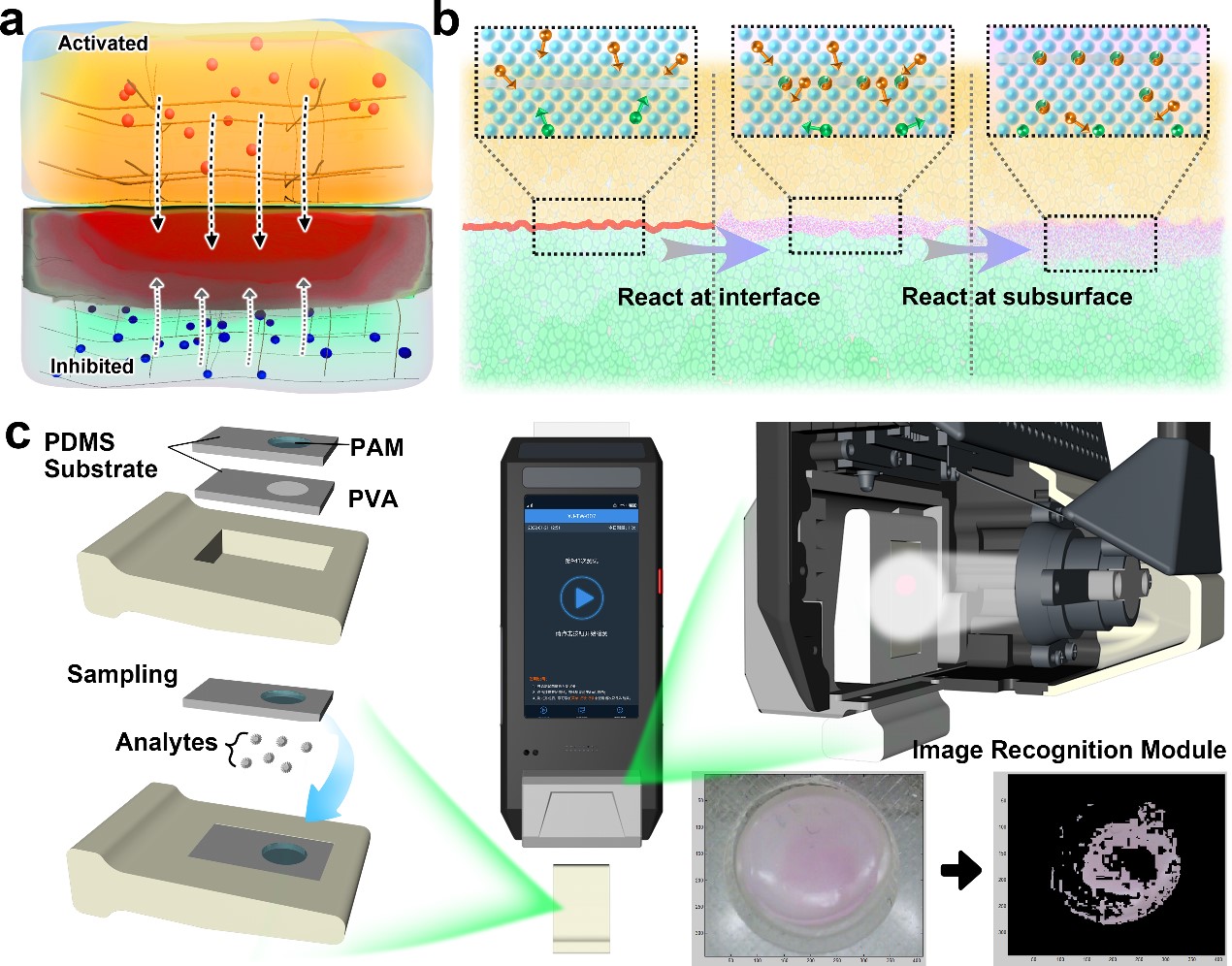Researchers first constructed asymmetric diffusion in bilayer hydrogel device to enhance the colorimetric sensing signal
Editor: | Aug 18,2022
The construction of ultrasensitive sensors plays an important role especially in the analysis of hazardous chemicals in environmental monitoring and safety supervision, biomarkers in disease surveillance and in vivo imaging. Probe-based sensor is among the most regular method for trace analysis due to the significant advantages, including real-time monitoring, high specificity and rapid response. As the most commonly employed medium to embed probe, liquid phase is favorable for probe molecules to effectively collide with the target analyte and thus to greatly promote the reaction speed and efficiency. However, the free volume diffusion characteristic in liquid medium would lead to the dispersion of the reaction signal, resulting in a further weakened signal from trace analytes, which is undesirable for the ultrasensitive detection. Hydrogel can limit solute diffusion through non-covalent action of polymer chain and screening effect of polymer network. However, for the isotropic hydrogel material, the limited diffusion property may reduce the effective collision of the reaction and the detection sensitivity. The chemical reaction at the two-phase interface is affected by the chemical potential of the system, which can avoid the diffusion of the solution as well as limit the migration direction of the reactants. Thus, it is of great significance to explore a reliable method to construct a reaction interface with asymmetric diffusion property in the hydrogel system to effectively limit signal diffusion while maintaining rapid reaction, and to improve the sensitivity of trace detection.
The researchers designed a bilayer hydrogel system with asymmetrical diffusion behaviors to enhance the sensing signal with polyacrylamide (PAM) layer realizing an instantaneous two-step reaction for sampling and diazotizing nitrite while polyvinyl alcohol (PVA) layer capturing the coupled chromogenic reaction. To destroy the diffusion symmetry of the two tightly contacted hydrogels, a pore size ratio of 10 and a diffusion coefficient ratio of 1.7 between PAM and PVA were controlled through the synthesis. The experiments showed that the diffusion of chromogenic products in the normal direction of the hydrogel was obviously limited, and the in-plane diffusion was also effectively limited due to the asymmetric diffusion properties of PAM and PVA hydrogels. The colorimetric sensor designed based on this principle showed the limitation of detection with 2.898 ng nitrite, showing excellent sensitivity and anti-interference. Moreover, the well-maintained target residue pattern information further convinced the importance of diffusion control to enhance sensing signal, as well as for the construction of a high-performance portable detector for practical scenarios.
This work was supported by the West Light Foundation of the Chinese Academy of Sciences, National Natural Science Foundation of China, the Youth Innovation Promotion Association, CAS, Key Research Program of Frontier Sciences and Natural Science Foundation of Xinjiang.
More information: Xincun Dou, Bilayer Hydrogel Sensor Boosted ng-level Solid Nitrite Detection through Asymmetrical Diffusion Construction Facilitated Colorimetric Signal Enhancement, Sensors and Actuators B: Chemical, 2022, 369, 132324. https://doi.org/10.1016/j.snb.2022.132324

Schematic illustrations of (a) the confined diffusion hydrogel system, (b) migration of the “reaction interface” relative to the contact interface to subsurface of the diffusion-inhibited phase from the initial contact to the final equilibrium state and (c) the working principle of the colorimetric detector for nitrite.
附件下载:
 (86) 991-3838931
(86) 991-3838931 lhskj@ms.xjb.ac.cn
lhskj@ms.xjb.ac.cn (86)991-3838957
(86)991-3838957 40-1 Beijing Road
Urumqi, XinjiangChina
40-1 Beijing Road
Urumqi, XinjiangChina